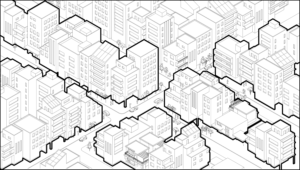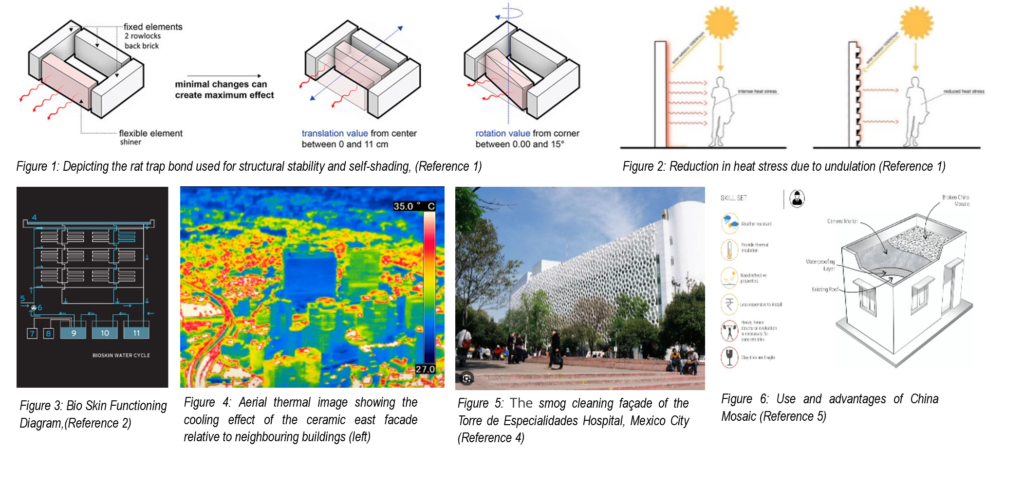Objective of the manifesto

In an age defined by climate change, this manifesto strives to motivate designers by evoking their consciousness, to design the building envelopes not just for indoor comfort and aesthetics, but also ensuring the creation of outdoor thermal havens as these envelopes comprise approximately 70 % of the urban outdoor environment. Hence by evolving their design, one can fully utilize their power to play a pivotal role in advancing public health and outdoor comfort.
Since the 1980s, regulations have pushed for better U-valued building envelopes to improve indoor comfort to reduce heating or cooling demands, strongly linking indoor thermal comfort and building envelope. However, this design manifesto urges the paradigm to also encompass the building envelopes’ impact on outdoor comfort, health, and urban microclimates. This shift, driven by the urgent challenges posed by climate change and Urban Heat Island effects, is not just an academic exercise; but a practical endeavor that transforms urban spaces into health-promoting sanctuaries.
Plan of Action
To explore this concept further, we delve into innovative building envelope strategies that shape new microclimates and foster healthier communities. Our research zeroes in on some of such envelopes as a transformative tool, aiming to elevate the holistic outdoor comfort and well-being of city dwellers, ensuring our cities thrive and steer clear of extinction.
The following narration delves into our research, where each building talks about the role it can play in improving the city’s microclimate
In the expansion of the above narrative, these techniques are detailed further for the manifesto to become a plan of action –
Undulated Rat Bond Brick Facades: Cooling the Urban Jungle
Brick facades can reduce urban heat stress for pedestrians by 26% as they have low reflectivity compared to insulated structures. This effect is amplified by incorporating undulated designs that create self-shading, thereby minimizing heat radiation. This balance between structural stability and self-shading was researched in the paper Climate-Resilient Robotic Facades by use of rat-trap bond (Figures 1 &2 ). By moving the shiner brick by half the length of the brick and rotation angle between 0° to 15° against the incidence angle of the Sun, reduced solar reflection and absorbed radiation and hence surface temperature and air temperature by 4.7°C and 1.8°C respectively.
Bioskin Facade: Nature’s Cooling Technique
Inspired by the traditional technique of sprinkling water on streets to cool them, a Bioskin façade has been designed by Nikken Sekkei. In this system, the collected rainwater is filtered and sterilized and then pumped through a network of porous ceramic pipes which act as a sprinkler system (Figure 3). Due to evaporative cooling, it reduces the surface temperature of the building by as much as a total of 12°C and the surrounding air by 2°C. (Figure 4)
Smog Eating Façade: Cleaning the Air
The tiled facade tiles coated with titanium dioxide, created by architecture firm Elegant Embellishments (Figure 5), act as a catalyst when activated by sunlight thereby converting mono-nitrogen oxides (the main constituent of smog) into less harmful substances such as calcium nitrate and water, along with some carbon dioxide. The titanium dioxide in the tiles doesn’t change; it can keep on doing its thing indefinitely. As per research about 2500 sqm of façade is needed to negate the effects of about 1000 cars a day.
China Mosaic Roofs: Albedo Magic
China mosaic on terraces can contribute to reducing the Urban Heat Island (UHI) effect, due to their high reflectivity (Albedo Effect) being light-colored and glossy, they reflect a significant portion of solar radiation back into the atmosphere during the day and at night, these materials can also help in radiative cooling, as they are efficient in emitting any absorbed heat back into the atmosphere(Figure 6). This property helps in reducing the surface temperature of the building by 3.5°C and the surrounding air by about 1°C.
Green Wall and Green Roof: Nature’s Thermostat
A green wall or roof only absorbs 10% of the sun’s heat energy while concrete roofs absorb 90% of it. Also, vegetation holds water, which in the process of evapotranspiration, not only cools the surface and low-level atmosphere but also lowers the amount of energy held in the surface and radiates as heat. Green facades reduce surface temperature by 11.58°C and surrounding air by 1.12°C and the green roof fraction must be close to 90% to reduce the near-surface UHI by 0.5 °C.
Undulated Facades: Nature’s Wind Symphony
Apart from self-shading, the protrusions in undulated facades cause swirling wind patterns, increasing the wind speed in localized areas, and causing turbulence, which effectively slows down the wind. They can also channel the wind into narrower paths, increasing its speed due to the Venturi effect – a phenomenon where the wind speeds up as it passes through a constricted space.

Conclusion: Building Envelopes as Agents of Transformation
The exploration of building envelopes uncovers their potential as catalysts for change. They emerge as pivotal elements in crafting healthier, more comfortable urban environments. By transcending traditional roles, building envelopes become our allies in addressing climate change and battling urban heat islands. This manifesto isn’t just words; it’s a call to action to ignite transformative change on every scale. Together, it’s our shared responsibility to make cities that have lively streets rather than dormant ones, and urban dwellers happy and healthy in their local environment whether indoor or outdoor.

References:
Fleckenstein, Julia, et al. ‘Climate-Resilient Robotic Facades: Architectural Strategies to Improve Thermal Comfort in Outdoor Urban Environments Using Robotic Assembly’. Frontiers in Built Environment, vol. 8, 2022. Frontiers, https://www.frontiersin.org/articles/10.3389/fbuil.2022.856871.
‘NBF Osaki Building | Office | Projects’. NIKKEN SEKKEI LTD, https://www.nikken.co.jp/en/projects/office/nbf_osaki_building.html.
Andoni, Heri, and Surjamanto Wonorahardjo. ‘A Review on Mitigation Technologies for Controlling Urban Heat Island Effect in Housing and Settlement Areas’. IOP Conference Series: Earth and Environmental Science, vol. 152, May 2018, p. 012027. DOI.org (Crossref), https://doi.org/10.1088/1755-1315/152/1/012027.
Magazine, Smithsonian. ‘Smog-Eating Buildings Battle Air Pollution’. Smithsonian Magazine, https://www.smithsonianmag.com/innovation/smog-eating-buildings-battle-air-pollution-180954781/.
???????????. Amid rising heatwaves, ‘Cool-Roofs’ can save lives. Here’s how. 20 June 2023, https://www.gaonconnection.com/lead-stories/bihar-heatwave-climate-change-environment-telangana-cool-roofs-52246.

